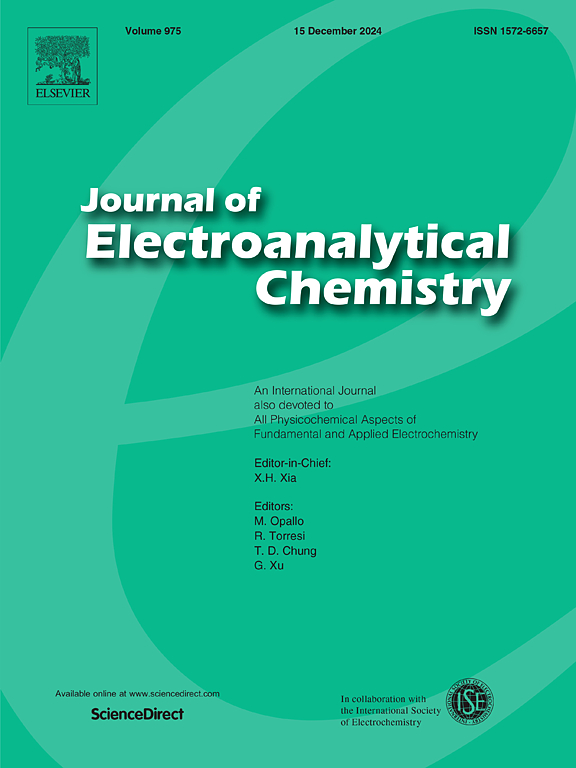Modification of flame etched carbon-fiber microelectrode (FE-CFME) by single walled carbon nanotube/pyreneacetic acid (SWCNT/PAA) nanocomposite for sensitive and selective detection of dopamine
IF 4.1
3区 化学
Q1 CHEMISTRY, ANALYTICAL
引用次数: 0
Abstract
An inexpensive, simple and fast methode of sensor construction as well as negligible sensor surface fouling, along with the high sensitivity and selectivity has always been a challenge in the fabrication of electrochemical sensors. In this study, to achieve this goal, carbon fiber microelectrode (CFME) was pretreated by applying fast flame etching and then simply modifed by pyrene acetic acid (PAA) decorated single walled carbon nanotube (SWCNT) nanocomposite for highly sensitive and selective dopamine (DA) detection. The results show that, although the CFME became active upon flame etching due to introduces nanometer-scale roughness features on it, surface modification by SWCNT-PAA further increases its sensitivity due to synergistic effects. Attaching PAA onto SWCNTs can effectively inhibit the π-stacking of the SWCNTs to prevent their agglomeration and offer a large surface area of electrode, as well as enhancing the diffusion of positively charged DA by its anionic carboxylate moieties. This is the first report on applying PAA/SWCNT nanocomposite for surface modification of flame etched carbon fiber microelectrode (FE-CFME). The surface morphology of the Bare-CFME, FE-CFME, and FE-CFME/SWCNT-PAA electrodes were evaluated using Field-emission scanning electron microscopy (FE-SEM), being correlated with the electrochemical characteristics observed by cyclic voltammetry (CV), and electrochemical impedance spectroscopy (EIS) techniques. As expected, the fabricated sensor showed improved electrochemical response with high sensitivity and selectivity. Under optimum conditions, this sensor exhibited high performance toward DA determination with good linearity in a broad linear range of 0.5 to 22 μM with the detection limit of 12.9 nM, and excellent reproducibility and repeatability. The practical applicability of the fabricated sensor has been successfully tested for the determination of DA in human serum and injection ampoule samples with recovery rates ranging from 98 % to 105 % and relative standard deviations below 3.1 %.

单壁碳纳米管/芘乙酸(SWCNT/PAA)纳米复合材料修饰火焰蚀刻碳纤维微电极(FE-CFME)对多巴胺的敏感和选择性检测
一种廉价、简单、快速的传感器构建方法,以及可忽略的传感器表面污垢,以及高灵敏度和选择性一直是电化学传感器制造的挑战。为了实现这一目标,本研究通过快速火焰刻蚀对碳纤维微电极(CFME)进行预处理,然后用芘乙酸(PAA)修饰的单壁碳纳米管(SWCNT)纳米复合材料进行简单修饰,用于高灵敏度和选择性的多巴胺(DA)检测。结果表明,虽然CFME在火焰刻蚀时由于引入了纳米尺度的粗糙度特征而具有活性,但swcnts - paa表面改性由于协同效应进一步提高了其灵敏度。PAA附着在SWCNTs上可以有效抑制SWCNTs的π堆积,防止其团聚,提供较大的电极表面积,并通过其阴离子羧酸基团增强带正电的DA的扩散。本文首次报道了PAA/ swcnts纳米复合材料用于火焰蚀刻碳纤维微电极(FE-CFME)的表面改性。利用场发射扫描电镜(FE-SEM)对Bare-CFME、FE-CFME和FE-CFME/ swcnts - paa电极的表面形貌进行了评价,并与循环伏安法(CV)和电化学阻抗谱(EIS)技术观察到的电化学特性进行了关联。结果表明,该传感器具有较高的灵敏度和选择性。在最佳条件下,该传感器在0.5 ~ 22 μM的宽线性范围内具有良好的线性度,检测限为12.9 nM,重现性和重复性良好。该传感器已成功地用于测定人血清和注射安瓿样品中的DA,回收率为98% ~ 105%,相对标准偏差小于3.1%。
本文章由计算机程序翻译,如有差异,请以英文原文为准。
求助全文
约1分钟内获得全文
求助全文
来源期刊
CiteScore
7.80
自引率
6.70%
发文量
912
审稿时长
2.4 months
期刊介绍:
The Journal of Electroanalytical Chemistry is the foremost international journal devoted to the interdisciplinary subject of electrochemistry in all its aspects, theoretical as well as applied.
Electrochemistry is a wide ranging area that is in a state of continuous evolution. Rather than compiling a long list of topics covered by the Journal, the editors would like to draw particular attention to the key issues of novelty, topicality and quality. Papers should present new and interesting electrochemical science in a way that is accessible to the reader. The presentation and discussion should be at a level that is consistent with the international status of the Journal. Reports describing the application of well-established techniques to problems that are essentially technical will not be accepted. Similarly, papers that report observations but fail to provide adequate interpretation will be rejected by the Editors. Papers dealing with technical electrochemistry should be submitted to other specialist journals unless the authors can show that their work provides substantially new insights into electrochemical processes.

 求助内容:
求助内容: 应助结果提醒方式:
应助结果提醒方式:


